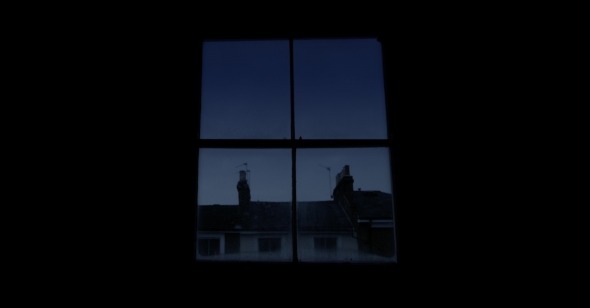Tense Moments
Michael Koresky on Fear Itself
Fear Itself plays Saturday, January 7, with Charlie Lyne in person, as part of Museum of the Moving Image’s First Look 2017.
In a sense, all art criticism, from academic analyses to 140-character rages, is an attempt to express what it is that a particular piece of work takes from as well as does to us—how it expresses our desires or anxieties, but also how it exploits them. Those of who regularly watch and try to describe the peculiar effect of horror movies are especially attuned to our own perceived desires and anxieties, as so plainly do these films express and exploit them. To return again and again to horror movies (even the same ones over and over) is to be poked and prodded until we come to a working definition of what scares us, and thus are better prepared for what the world might throw at us. If the aesthetic qualities of cinema “lay bare the realities,” as André Bazin put it, then horror movies in particular have the ability to strip us to the bone. This is the world beneath this world, the one we don’t want to see in real life, but are willing to occasionally visit from behind the safety of a screen.
Charlie Lyne’s Fear Itself, an essay film that functions both as a dreamy interior monologue and an intuitively assembled movie highlight reel, interrogates our willingness to visit this world. After an unseen narrator, speaking with a tremulous voice, tells us—against the unsettling image of a gloomy, slowly fading evening window—about the time she spent recuperating from a terrible accident and keeping herself grim company with horror films, Lyne moves into a feature-length string of clips from a century’s worth of scary movies, from iconic to obscure, all accompanied by the same whispery, hypnotic voiceover, beckoning us to enter its headspace. There is very little specific analysis of individual films; instead the scenes function as memory shards, images cascading through our narrator’s head. A result is that films as disparate as Altered States, Nosferatu, 1984, The Night of the Hunter, Repulsion, Tetsuo the Iron Man, M, and Sette note in nero are placed on the same emotional plane, each an evocation of all-purpose, free-floating, indefinable anxiety.
Lyne’s project isn’t to study filmmaking, and there isn’t much here in the way of visual or structural reading. We see glimpses of Psycho, Don’t Look Now, and Carnival of Souls not so that we can admire them on technical or aesthetic levels but so that we can appreciate how they get inside of us. At the same time, it’s not a fully psychoanalytic reading either, but a de-academicized, layman’s experiment, an attempt to humble the viewer as an awed participant. As such it’s rather old-fashioned in its approach, with its occasionally clunky voiceover (“Whether we realize it or not, our anxieties are always with us”) sometimes doing not much more than creating a lengthy variation on those movie clip roundups reiterating how we’re all helplessly in thrall to cinema’s power. Lyne’s film is about complete immersion, and therefore the film calls for a lack of analytical distancing between the viewer and the screen image, which produces a narcotizing effect that’s both sensually powerful and critically counterproductive. It’s doubtful the viewer will emerge from Fear Itself understanding any more about how movies work than when they went in; it’s more like falling into a dream—it’s its own closed circuit.
Functionally, the film creates its own form of suspense, building anticipation from what’s around the next corner. That the jolts of gore are only occasional makes them all the more disturbing, as in an unwelcome cut to the climax of French extremity cornerstone Martyrs, or a rude interruption by Nico B. and Rozz Williams’s hideous, black-and-white short Pig. And while it’s gratifying to see such generically non-horror films as Post Tenebras Lux, Code Unknown, Enduring Love, and both versions of Elephant (Gus Van Sant’s and Alan Clarke’s) in the mix, as unexpected twists and as reminders of those films’ peculiar nightmarish power, it’s most intriguing to see how Lyne uses passages from classic horror films to create dissonance or go against expectation. Scenes from Jaws, The Strangers, Twilight Zone: the Movie, and Night of the Demon cut off provocatively before their respective money shots (in the latter case, nope, no rubber demon here to scare the pants off your inner five-year-old), while little Pearl’s eerie lullaby from The Night of the Hunter carries over into images from It Follows; this establishes not just a continuum of cinematic horror across decades, it produces an unsettling nightmarish effect in which one heretofore contained world seeps into the next.
In the narration, Lyne argues that films have a lot invested in keeping us scared, and in one of his most provocative lines, that horror films pare the world down to “a few vague signals.” This is a fairly good working thesis for Fear Itself, which is reductive by design, but pleasantly so. Lyne’s incorporation of the different endings of Terry Gilliam’s Brazil—the “Love Conquers All” version enforced by the studio and the despairing original—does a good job of encapsulating his entire essay, which essentially comes to the unsettling conclusion that movies cannot protect us from the world or ourselves. In Brazil, a deranged and tortured Sam Lowry just keeps dreaming to insulate himself from a nightmarish reality; with horror movies, we hope for catharsis by willingly entering a nightmare.
